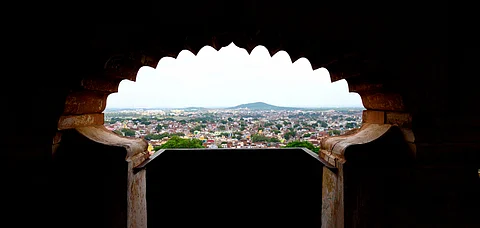
- Destinations
- Experiences
- Stay
- What's new
- Editor’s Picks
- Responsible Tourism
- CampaignsCampaigns
- Subscribe

On one hand, owing to its theme, it can be compared with the Sun Temple of Konark (Odisha). On the other hand, owing to its sculptures, it begets comparison with the temples of Khajuraho (Madhya Pradesh). Both not only draw travellers from around the globe but are also part of UNESCO&rsquos World Heritage List. But look at Mahoba of Uttar Pradesh, said my guide, hardly anybody has heard about this place. We were standing in front of Mahoba&rsquos ninth century Sun Temple. Dilapidated though it was, the granite temple still bore traces of its glorious past.
In Jhansi for Uttar Pradesh Tourism&rsquos city-centric festival, I decided to use the opportunity to explore Bundelkhand, a lesser known former kingdom in the heart of India. Once upon a time, it included parts of both Uttar Pradesh and Madhya Pradesh.
Originally known as Mahotsav-nagar, owing to the grand celebration that Chandravarman, founder of the Chandela dynasty, organised here, Mahoba is 140km from Jhansi by road. Chandravarman shifted his capital to Mahoba sometime in the 9th century when he decided to convert his former capital, Khajuraho, into a temple city. Today, little remains of the Chandela capital save for a few lakes and the ruined temples. The Sun Temple was located on the bank of Rahila Sagar. The Vijay Sagar Lake is known to shelter migratory birds in winter. A chance meeting with a balladeer in the local market may acquaint you with the tales of Alha and Udal, the warrior siblings, who is believed to have fought for the Chandelas in their war against Prithviraj Chauhan. At one end of the town is Gorakhgiri, the abode of Jain ascetic Gorakhnath. While in Mahoba, do not forget to sample the locally grown betel leaf ('paan').
Chitrakoot (about 125km from Mahoba) is a pilgrim town shared by Uttar Pradesh and Madhya Pradesh, with the Mandakini River drawing the border between the two states. With a night halt at Chritrakoot, it is a comfortable drive of 70km to Kalinjar. A steep flight of stairs will take you to the hill top fort. Apparently, the fort was so securely built by the Chandela rulers that it could not be breached outright. Witness to many battles and occupants, the fort contains temples, palaces and other structures, many still decorated with fine sculptures. The 12th century Nilkantha Mahadev temple is big attraction.
If you have some time in hand, pay a visit to Deogarh, about 140km from Jhansi. Ruled by several dynasties, it is better known for its sculptures dating back to the Gupta Period. One of the major attractions here is the finely sculpted 5th century Dashavatara Temple. There are also an old fort, rock-cut caves and some Jain temples here. The Betwa River bank is also picturesque.
Said to be the gateway to Bundelkhand, Jhansi is known for Queen Lakshmibai and her valiant fight against the British. The fort, from where she made that historic jump on horseback with her son tied on her back looms above the town. Little remains of the 17th century fort except its main structure and a couple of temples (dedicated to Ganesha and Shiva). Karak Bijli and Bhawani Shankar, two cannons used by the queen are also kept here. Besides the fort, you may also pay visits to the Government Museum and the Rani Mahal in town. In the evening, a light and sound show is organised at the Fort.
From Jhansi, you may continue in several directions, including travelling to Khajuraho, Gwalior or Orchha.
Getting there The two airports for Jhansi are Gwalior (98 km by road) and Khajuraho (178 km). Jhansi is well connected by rail with several important cities of India, including Delhi, Mumbai, Kolkata, etc. Jhansi, on National Highway No. 25 and 26, is linked by a good network of roads.
